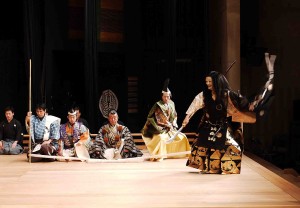Best Noh play 2016/12/18
Last night I went to National Noh Theater to watch Noh and Kyogen.
There are three major traditional theater arts in Japan, namely Noh, Bunraku and Kabuki.
Noh was established in 14th century while Bunraku and Kabuki ,established in 17th century, are descended from Noh.
Noh are played by Noh actors, musicians and group singers. Noh actors are divided into “ site” (principal actors) and “waki” (supporting actors) and secondary actors.
There are 5 old families of “ site”, namely Kanze, Konparu, Hosho, Kongo, Kita. And all these families have been basically succeeded by hereditary. For example, Kanze, biggest Noh family, have been succeeded for around 650 years since Kan-ami founded it in mid 14th century and the current head of the family is 26th generation.
Besides “site” families, there are families who specialize in “waki” role and also have been succeeded by hereditary.
The same thing can be said with Noh musicians and Noh singers. Noh music is composed of flute, small hand drum, large hand drum and drum. There are again old families who specialize in each musical instrument and have been succeeded by hereditary.
Yesterday’s program was ( Funa Benkei) which is one of the most popular Noh play.
It is the story about the historical fight between Heike and Genji in 12th century. Yoshitsune, the hero of the fight and younger brother of the head of Genji family, was defeated by the estranged elder brother after the fight and tried to escape from the capital by a boat with his strong supporter, Benkei. Then they were haunted by a revengeful ghost of lost Heike family, however finally they beat the ghost with Yoshitsune’s solid determination.
Tatsumi Manjiro who is from Hosho family and famous “site” actor, played Heike ghost so well with full impact that fully packed audiences were deeply moved and then applauded with cheers.








